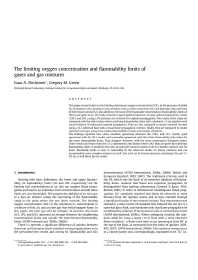Mining Publication: The Limiting Oxygen Concentration and Flammability Limits of Gases and Gas Mixtures
Original creation date: June 2009
This paper presents data on the limiting (minimum) oxygen concentration (LOC), in the presence of added N2, of methane (CH4, propane (C3H24), ethylene (C2H4), carbon monoxide (CO), and hydrogen (H2), and some of their binary mixtures. It also addresses the issue of the flammable concentration (flammability) limits of these pure gases in air. The study is based on spark ignited explosions in large, spherical laboratory vessels (120-L and 20-L) using a 7% pressure-rise criterion for explosion propagation. The results of the study are compared with the older values which used long flammability tubes with a diameter greater than or equal to 5 cm together with visual evidence of substantial upward propagation. They are also compared to results reported recently using a 12-L spherical flask with a visual flame propagation criterion. Finally, they are compared to results reported in Europe using more modest flammability criteria and smaller chambers. The findings reported here show excellent agreement between the 120-L and 12-L results, good agreement with the 20-L results, and reasonable agreement with the earlier flammability tube values for the lower flammability limits. They disagree, however, with the more conservative European values. These results and those from the 12-L experiments also feature lower LOCs than are given by traditional flammability tubes. A model for the LOCs of such fuel mixtures based on the Le Chatelier mixture rule for lower flammable limits is seen to reasonably fit the observed results on binary mixtures and can accommodate more complex mixtures as well. One such set of ternary mixtures containing CH4 and 1:1 CO:H2 is well fitted by the model.
Authors: IA Zlochower, GM Green
Peer Reviewed Journal Article - June 2009
NIOSHTIC2 Number: 20035461
J Loss Prev Process Ind 2009 Jul: 22(4):499-505
See Also
- Advances in Grid-Based Numerical Modeling Techniques for Improving Gas Management in Coal Mines
- Commercial-Quality Gas From a Multipurpose Borehole Located in the Pittsburgh Coalbed
- Detection and Control of Spontaneous Heating in Coal Mine Pillars-A Case Study
- Explosion Temperatures and Pressures of Metals and Other Elemental Dust Clouds
- Gas Sorption and Transport in Coals: A Poroelastic Medium Approach
- The Modified Direct Method: A Solution for Obtaining Accurate Coal Desorption Measurements
- Prediction of Longwall Methane Emissions: An Evaluation of the Influence of Mining Practices on Gas Emissions and Methane Control Systems
- Rapid (Grab) Sampling During Full-scale Explosions - Microscopic and Analytical Evaluation
- Reconciling Longwall Gob Gas Reservoirs and Venthole Production Performances Using Multiple Rate Drawdown Well Test Analysis
- A Technique for Measuring Toxic Gases Produced by Blasting Agents
- Content source: National Institute for Occupational Safety and Health, Mining Program


 ShareCompartir
ShareCompartir
